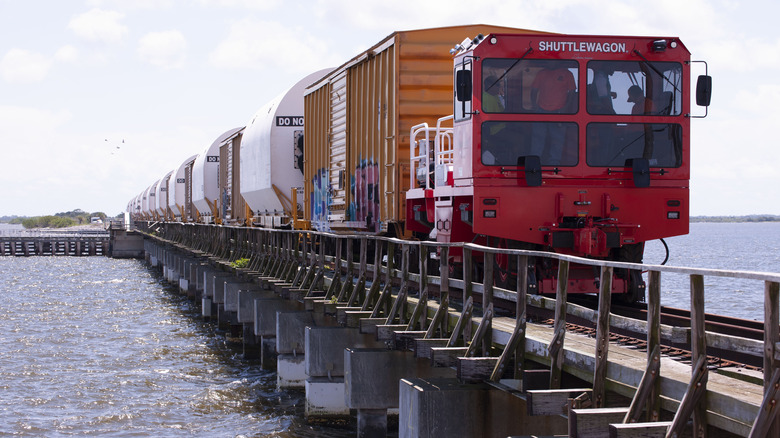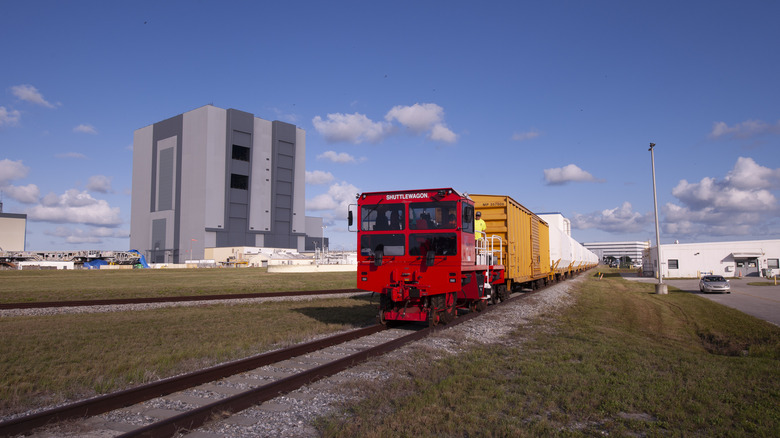The Real Reason NASA Has Its Own Railroad
When you think of the National Aeronautics and Space Administration (NASA), you probably imagine spaceships, moon missions, and robots on Mars. What you probably don't think about are good old-fashioned trains, but trains have always been a vital component to the success of NASA's space missions. Why? How else do you think they move around all those incredibly large and heavy booster rockets?
A 38-mile industrial line dubbed "The NASA Railroad" crisscrosses the expansive Kennedy Space Center at in Florida, as well as connecting to tracks at Cape Canaveral. In 1963, the Florida East Coast Railway built a 7.5-mile connection to the Kennedy Space Center that joined the 28 miles of NASA-constructed track at Wilson's Corners junction. Part of that 7.5-mile line included a drawbridge over the Indian River, which entered the space center's restricted zone. The draw span of the bridge always stays up until a train needs to enter, at which time the crew lowers the bridge and allows the train to enter the restricted zone.
According to NASA, the Florida East Coast Railway built two 7-track rail yards, one called "Jay Jay" and the other named "Wilson." The nine-mile Jay Jay line runs east towards the Atlantic Ocean to NASA's launch pads and the aforementioned Air Force tracks at Cape Canaveral. The line just east of Wilson, also a nine-mile stretch, heads to NASA's vehicle assembly building and Kennedy Space Center's industrial area.
The NASA trains carried heavy loads
In 1983, NASA bought the Florida East Coast portion of the railroad because the hazardous materials hauled over it for the space shuttle — like the solid rocket boosters — required a rebuild and upgrade of the entire line. They also replaced the antiquated World War II era Alco S2 locomotives with three EMD SW-1500 locomotives — numbered 1, 2, and 3 — built between 1968 and 1970 for the Toledo, Peoria, and Western Railways. The rebuild and engine upgrades allowed NASA to move heavier loads at faster speeds.
The segment cars that carried the solid rocket boosters for the space shuttle made up most of the traffic on the NASA Railroad. According to NASA, each of the two booster rockets was made up of four segments that were 32 feet long, 12 feet in diameter, and weighed an average of 150 tons. Each segment car weighed 510,000 pounds, and each launch required the delivery of eight segment cars. The booster rockets delivered to Kennedy came from the Thiokol plant in Wasatch, Utah, over a route using various private railways, including the Union Pacific, Kansas City Southern, Norfolk Southern, CSX, and Florida East Coast Railway.
The NASA trains hit their final stop
According to the Southeastern Railway Museum, the NASA Railroad carried approximately 30,000 carloads of materials during its first five years of operation. However, after the final booster segments were shipped in 2010, the use of the railroad diminished. With an operating cost of $1.3 million a year, NASA stopped using it in 2015. A great deal of the track remains, but NASA gave away all three locomotives. Number 2 was given to the Gold Coast Railroad Museum in Miami in 2014. A year later NASA sent Number 1 to Natchitoches Parish Port in Natchitoches, Louisiana, and Number 3 to the Madison Railroad in Madison, Indiana, to be used for freight service and passenger excursions.
A few years ago, the "rocket railroad" came back to life, albeit briefly. On June 15, 2020, 10 rocket booster segments arrived by train from the Northrop Grumman plant in Promontory, Utah. The 10-day, 2,800-mile trip carried the booster segments destined to be used for the Space Launch System rocket and Orion spacecraft.

